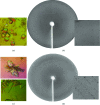Large-scale purification and crystallization of the endoribonuclease XendoU: troubleshooting with His-tagged proteins
- PMID: 16511328
- PMCID: PMC2197201
- DOI: 10.1107/S1744309106006373
Large-scale purification and crystallization of the endoribonuclease XendoU: troubleshooting with His-tagged proteins
Abstract
XendoU is the first endoribonuclease described in higher eukaryotes as being involved in the endonucleolytic processing of intron-encoded small nucleolar RNAs. It is conserved among eukaryotes and its viral homologue is essential in SARS replication and transcription. The large-scale purification and crystallization of recombinant XendoU are reported. The tendency of the recombinant enzyme to aggregate could be reversed upon the addition of chelating agents (EDTA, imidazole): aggregation is a potential drawback when purifying and crystallizing His-tagged proteins, which are widely used, especially in high-throughput structural studies. Purified monodisperse XendoU crystallized in two different space groups: trigonal P3(1)21, diffracting to low resolution, and monoclinic C2, diffracting to higher resolution.
Figures


Similar articles
-
Functional characterization of XendoU, the endoribonuclease involved in small nucleolar RNA biosynthesis.J Biol Chem. 2005 May 13;280(19):18996-9002. doi: 10.1074/jbc.M501160200. Epub 2005 Mar 7. J Biol Chem. 2005. PMID: 15755742
-
Purification, cloning, and characterization of XendoU, a novel endoribonuclease involved in processing of intron-encoded small nucleolar RNAs in Xenopus laevis.J Biol Chem. 2003 Apr 11;278(15):13026-32. doi: 10.1074/jbc.M211937200. Epub 2003 Feb 5. J Biol Chem. 2003. PMID: 12571235
-
The structure of the endoribonuclease XendoU: From small nucleolar RNA processing to severe acute respiratory syndrome coronavirus replication.Proc Natl Acad Sci U S A. 2006 Aug 15;103(33):12365-70. doi: 10.1073/pnas.0602426103. Epub 2006 Aug 8. Proc Natl Acad Sci U S A. 2006. PMID: 16895992 Free PMC article.
-
Identification of small-molecule inhibitors of the XendoU endoribonucleases family.ChemMedChem. 2011 Oct 4;6(10):1797-805. doi: 10.1002/cmdc.201100281. Epub 2011 Jul 29. ChemMedChem. 2011. PMID: 21805647 Free PMC article.
-
Affinity Tags for Protein Purification.Curr Protein Pept Sci. 2020;21(8):821-830. doi: 10.2174/1389203721666200606220109. Curr Protein Pept Sci. 2020. PMID: 32504500 Review.
Cited by
-
The tumor marker human placental protein 11 is an endoribonuclease.J Biol Chem. 2008 Dec 12;283(50):34712-9. doi: 10.1074/jbc.M805759200. Epub 2008 Oct 20. J Biol Chem. 2008. PMID: 18936097 Free PMC article.
-
DMSO tolerant NAD(P)H recycler enzyme from a pathogenic bacterium, Burkholderia dolosa PC543: effect of N-/C-terminal His Tag extension on protein solubility and activity.Eng Life Sci. 2018 Oct 31;18(12):893-903. doi: 10.1002/elsc.201800036. eCollection 2018 Dec. Eng Life Sci. 2018. PMID: 32624883 Free PMC article.
-
A Chimeric Affinity Tag for Efficient Expression and Chromatographic Purification of Heterologous Proteins from Plants.Front Plant Sci. 2016 Feb 15;7:141. doi: 10.3389/fpls.2016.00141. eCollection 2016. Front Plant Sci. 2016. PMID: 26913045 Free PMC article.
-
Removal of the tag from His-tagged ILYd4, a human CD59 inhibitor, significantly improves its physical properties and its activity.Curr Pharm Des. 2012;18(27):4187-96. doi: 10.2174/138161212802430486. Curr Pharm Des. 2012. PMID: 22642361 Free PMC article.
-
Isolation of Metarhizium anisopliae carboxypeptidase A with native disulfide bonds from the cytosol of Escherichia coli BL21(DE3).Protein Expr Purif. 2012 Mar;82(1):116-24. doi: 10.1016/j.pep.2011.11.015. Epub 2011 Dec 14. Protein Expr Purif. 2012. PMID: 22197595 Free PMC article.
References
Publication types
MeSH terms
Substances
LinkOut - more resources
Full Text Sources
Miscellaneous

